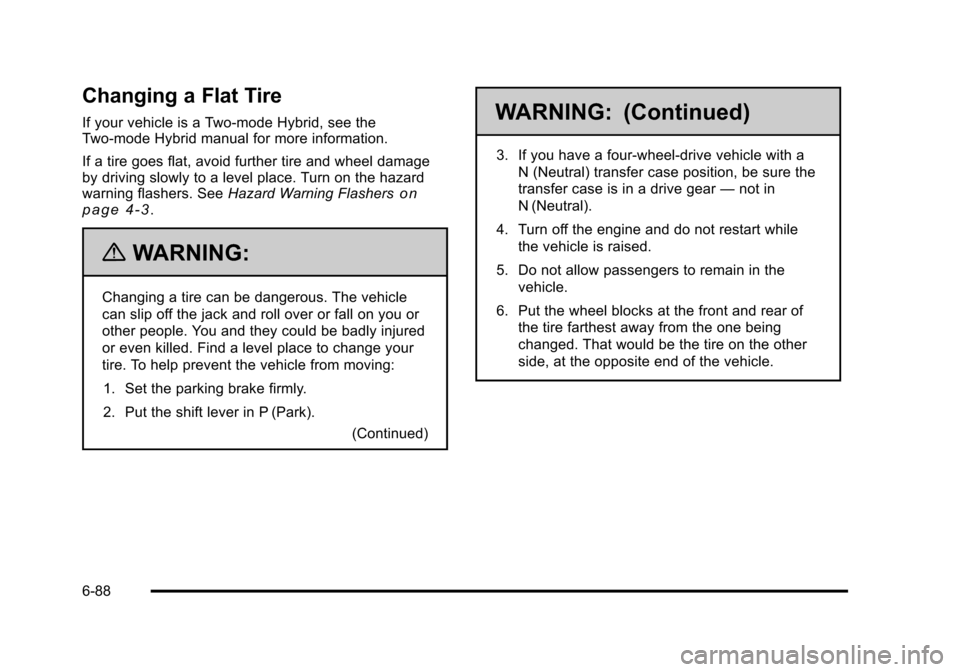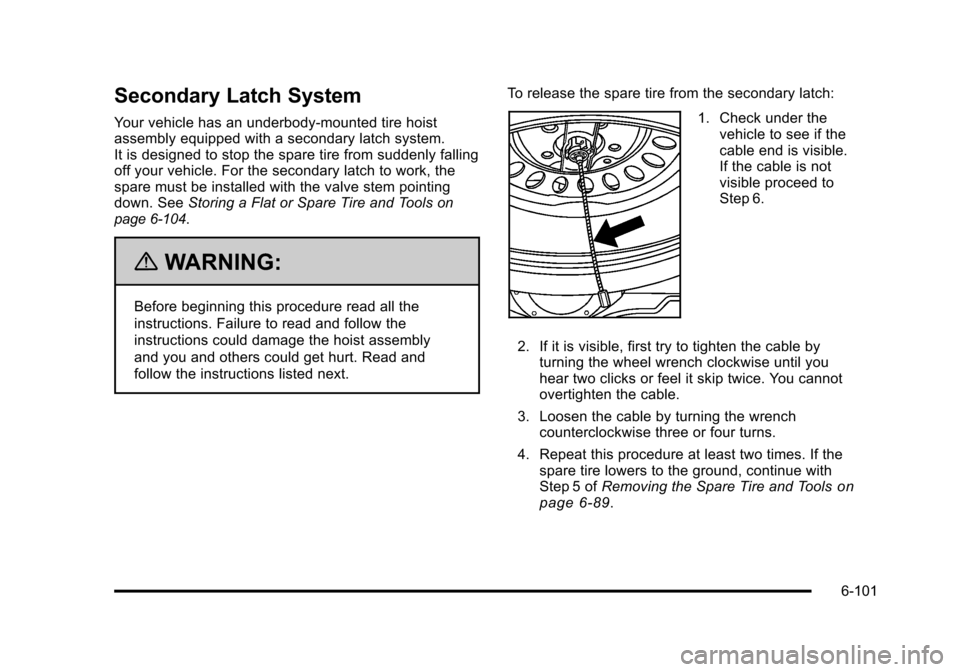Page 514 of 608

Changing a Flat Tire
If your vehicle is a Two-mode Hybrid, see the
Two-mode Hybrid manual for more information.
If a tire goes flat, avoid further tire and wheel damage
by driving slowly to a level place. Turn on the hazard
warning flashers. SeeHazard Warning Flashers
on
page 4‑3.
{WARNING:
Changing a tire can be dangerous. The vehicle
can slip off the jack and roll over or fall on you or
other people. You and they could be badly injured
or even killed. Find a level place to change your
tire. To help prevent the vehicle from moving:
1. Set the parking brake firmly.
2. Put the shift lever in P (Park). (Continued)
WARNING: (Continued)
3. If you have a four-wheel-drive vehicle with aN (Neutral) transfer case position, be sure the
transfer case is in a drive gear —not in
N (Neutral).
4. Turn off the engine and do not restart while the vehicle is raised.
5. Do not allow passengers to remain in the vehicle.
6. Put the wheel blocks at the front and rear of the tire farthest away from the one being
changed. That would be the tire on the other
side, at the opposite end of the vehicle.
6-88
Page 515 of 608
When the vehicle has a flat tire (B), use the following
example as a guide to assist you in the placement of
wheel blocks (A).
A. Wheel Block
B. Flat Tire
The following information explains how to use the jack
and change a tire.
Removing the Spare Tire and Tools
The equipment you will need to change a flat tire is
stored under the storage tray, which is located on the
driver side trim panel (over the rear wheelhouse).
Regular Wheelbase shown, Extended Wheelbase similar
1. Remove the tray to access the tools by pulling up on the finger depression under the jack symbol.
6-89
Page 520 of 608
Once the retainer is separated from the guide pin,
tilt the retainer and pull it through the center of the
wheel along with the cable and latch.
8. Put the spare tire near the flat tire.
Removing the Flat Tire and Installing
the Spare Tire
1. Do a safety check before proceeding. See Changing a Flat Tireon page 6‑88for more
information.
2. If your vehicle has a center cap that covers the wheel fasteners, place the chisel end of the wheel
wrench in the slot on the wheel and gently pry the
cap out.
6-94
Page 522 of 608
Front Position–1500 ModelsFront Position –2500 Models
Front Tire Flat: If the flat tire is on a front tire of
the vehicle, you will need to use the jack handle
and only one jack handle extension. Attach the
wheel wrench to the jack handle extension. Attach
the jack handle to the jack (A). Position the jack
on the frame behind the flat tire where the frame
sections overlap. Turn the wheel wrench clockwise
to raise the vehicle. Raise the vehicle far enough
off the ground so there is enough room for the
spare tire to clear the ground.
6-96
Page 523 of 608
Rear Position–1500 ModelsRear Position –All Other Models
Rear Tire Flat: If the flat tire is on a rear
tire of the vehicle, you will need to use
the jack handle (B) and both jack handle
extensions (C). Attach the wheel wrench (D)
to the jack handle extensions (C). Attach the
jack handle (B) to the jack (A). Use the jacking
pad provided on the rear axle. Turn the wheel
wrench (D) clockwise to raise the vehicle.
6-97
Page 524 of 608
Raise the vehicle far enough off the ground so
there is enough room for the spare tire to clear the
ground.
{WARNING:
Getting under a vehicle when it is jacked up is
dangerous. If the vehicle slips off the jack, you
could be badly injured or killed. Never get under a
vehicle when it is supported only by a jack.
{WARNING:
Raising your vehicle with the jack improperly
positioned can damage the vehicle and even
make the vehicle fall. To help avoid personal
injury and vehicle damage, be sure to fit the jack
lift head into the proper location before raising the
vehicle.
5. Remove all of thewheel nuts.
6. Take off the flat tire.
6-98
Page 525 of 608
7. Remove any rust or dirtfrom the wheel bolts,
mounting surfaces, and
spare wheel.
{WARNING:
Rust or dirt on a wheel, or on the parts to which it
is fastened, can make wheel nuts become loose
after time. The wheel could come off and cause
an accident. When changing a wheel, remove any
rust or dirt from places where the wheel attaches
to the vehicle. In an emergency, use a cloth or
(Continued)
WARNING: (Continued)
a paper towel to do this; but be sure to use a
scraper or wire brush later, if needed, to get all
the rust or dirt off. SeeChanging a Flat Tire
on
page 6‑88
.
8. Put the wheel nuts back on with the rounded end of the nuts toward the wheel after mounting the
spare tire.
{WARNING:
Never use oil or grease on bolts or nuts because
the nuts might come loose. The vehicle's wheel
could fall off, causing a crash.
9. Tighten each wheel nut by hand. Then use the wheel wrench to tighten the nuts until the wheel is
held against the hub.
6-99
Page 527 of 608

Secondary Latch System
Your vehicle has an underbody-mounted tire hoist
assembly equipped with a secondary latch system.
It is designed to stop the spare tire from suddenly falling
off your vehicle. For the secondary latch to work, the
spare must be installed with the valve stem pointing
down. SeeStoring a Flat or Spare Tire and Tools
on
page 6‑104.
{WARNING:
Before beginning this procedure read all the
instructions. Failure to read and follow the
instructions could damage the hoist assembly
and you and others could get hurt. Read and
follow the instructions listed next. To release the spare tire from the secondary latch:
1. Check under the
vehicle to see if the
cable end is visible.
If the cable is not
visible proceed to
Step 6.
2. If it is visible, first try to tighten the cable by turning the wheel wrench clockwise until you
hear two clicks or feel it skip twice. You cannot
overtighten the cable.
3. Loosen the cable by turning the wrench counterclockwise three or four turns.
4. Repeat this procedure at least two times. If the spare tire lowers to the ground, continue with
Step 5 of Removing the Spare Tire and Tools
on
page 6‑89.
6-101